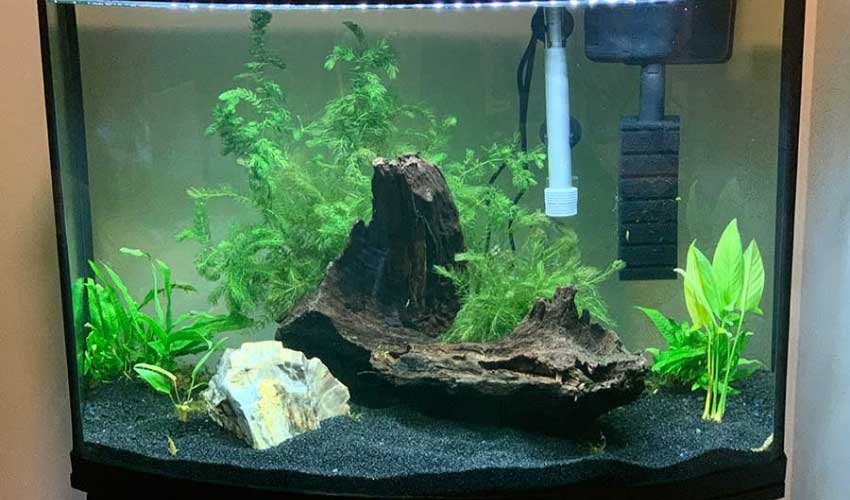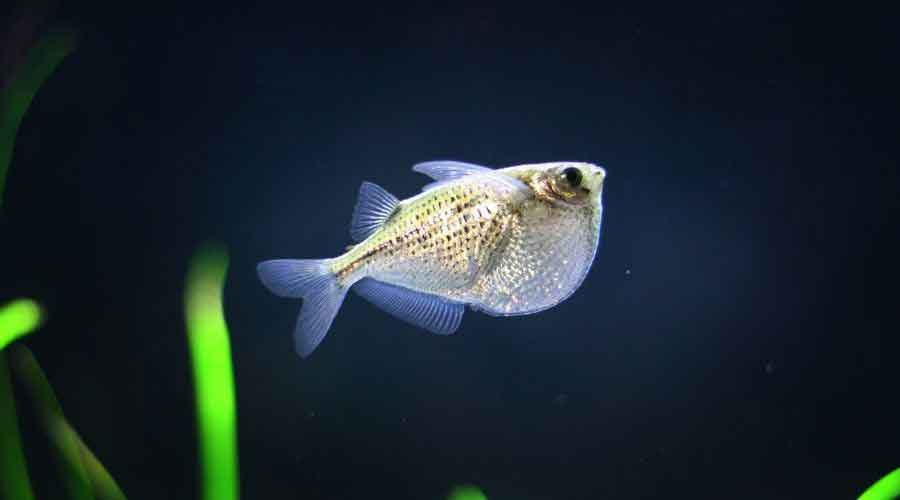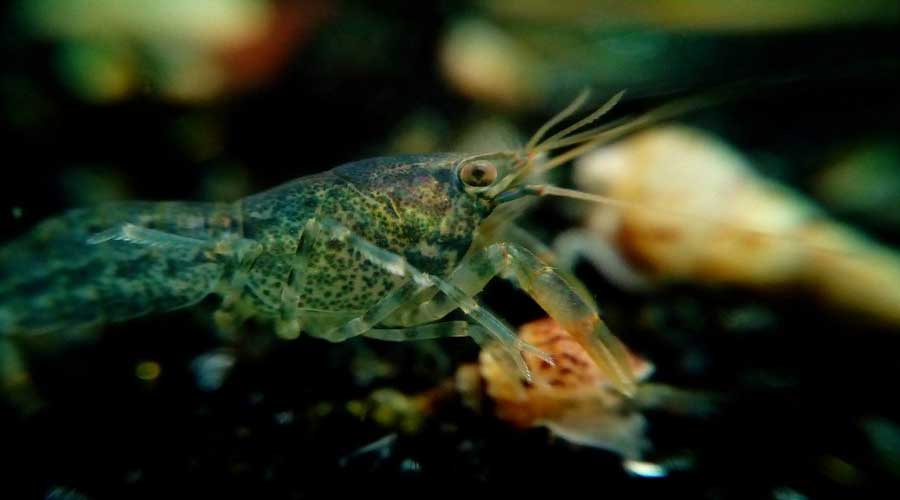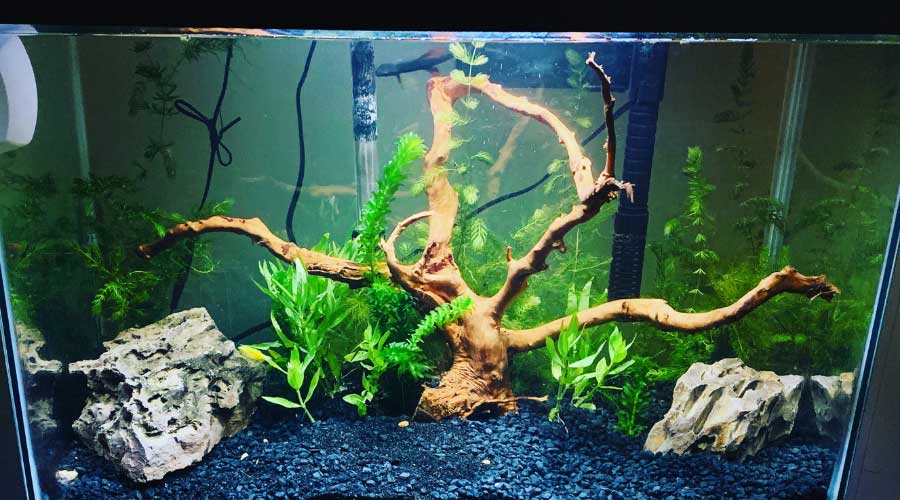In this blog, we’ll look at the blue dwarf crayfish and blue dwarf crayfish care. These little crays are beautiful and quite a bit different than other larger crayfish as you will see.
But, at the end of the day, they’re still like all crayfish in many ways.
Blue Dwarf Crayfish at a Glance
| Blue Dwarf Crayfish | |
|---|---|
| Origin: | Southeastern United States (selectively bred variation) |
| Care Level: | Beginner |
| Temperament: | Mostly peaceful |
| Feeding Type: | Omnivores |
| Minimum Tank Size: | 10 gallons (recommended) |
| Growth Size: | 1.6 to 2 inches |
| Lifespan: | 2 to 3 years |
Blue dwarf crays are hardy, don’t need much attention, and can live off of a variety of different foods.
Beginning aquarists should have no problem keeping these dwarf crayfish—assuming the tank is set-up right, and the dwarf crayfish is cared for properly.
The Origin of Blue Dwarf Crayfish
The blue dwarf crayfish is a variation of another type of dwarf crayfish that is indigenous to the Southeastern parts of the United States.
Blue dwarf crawfish are selectively bred for their beautiful blue colors.
How Big do Dwarf Blue Crayfish Get?
With a name like dwarf blue crayfish, you wouldn’t expect these little creatures to grow to be too big. And they don’t.
Dwarf blue crawfish grow to be just a little over 1.5 inches, give or take. So obviously, these blue crustaceans are pretty small, and get their name honest.
Temperament
Unlike bigger crayfish, blue dwarf crayfish are mostly peaceful crayfish. However, given the chance, they would probably love to eat the fish in your aquarium.
But, these guys are tiny and not all that aggressive (usually). And for this reason, you can keep these beauties in community fish tanks. More on this later.
Lifespan
Blue dwarf crays don’t live for very long, unlike some of the other larger crayfish that can live for 5 to 6 years.
These small crayfish, like other dwarf crayfish, only live for roughly 2 to 3 years.
In captivity, a dwarf crayfish’s lifespan can be impacted by the care (water conditions, feeding, and other aquatic life).
Molting
Like other crustaceans, blue dwarfs will molt several times throughout their lives.
As small crayfish, or maybe “young” is a better word, these crayfish will molt more frequently than when they are bigger. I mean older.
Most of the time, right before crayfish molt, you will notice that they become less active, hide, and stop eating. This is totally normal.
Molting is a pretty stressful time for crayfish. During a molt, crayfish become very weak and can become susceptible to attacks from other aquatic life.
It’s for this reason that crayfish of all types need hideouts throughout the fish tank. I’ll talk about hideouts further down in the article.
When a crayfish molts, it sheds its exoskeleton. It’s important that the exoskeleton be left in the tank as a crayfish will eat this to regain strength.
Interesting fact: crayfish can regenerate damaged limbs when they molt.
Determining the Sex of a Blue Dwarf
Determining the sex of crayfish is not too hard. To do so, simply flip a blue dwarf crayfish over.
If you look closely, you’ll notice that the males have an extra set of swimmerets that are large and pronounced. These sit near the rear of the crayfish.
Female dwarf blue crays will not have the extra swimmerets.
Setting up a Tank for Blue Dwarf Crayfish
Tank Size
Blue dwarf crayfish are sometimes kept in fairly small aquariums. However, I’d recommend at least a 10-gallon fish tank. This will allow room for other fish.
Also, larger tanks make managing water parameters a bit easier.
Community Tanks
Unlike larger crayfish, dwarf crayfish can do well in many community tanks.
Again, these guys are obviously crayfish, but they tend not to be as aggressive and destructive as crawfish like the electric blue crayfish, white crayfish, and other types of crayfish.
However, what you should be concerned with is the fish you choose to live with your dwarf crayfish.
You want to be sure and select fish that are also peaceful and won’t attack and eat your dwarf cray.
I’ll discuss tankmates in a bit.
Substrate
For substrate, I would suggest using fine sand or small gravel. I’m a fan of black sand as it makes the color of blue dwarf crayfish really stand out.
Hideouts
As mentioned above, crayfish need hideouts when they molt. But, crayfish also need hideouts because they like to burrow and hide.
My dwarf crayfish spends the majority of his time behind a rock in my aquarium. He’ll often come out when it’s feeding time or just to roam around sometimes.
There are a lot of different options for hideouts. You can use driftwood, rocks, store-bought hideouts, or make your own hideouts out of PVC.
To make hideouts out of PVC, buy 1.5 inch PVC pipe, cut them into six-inch pieces, and place them in your tank.
Ideally, a variety of hideouts can work really well and look good, too.
Plants and Blue Dwarf Crawfish

Aquarists have differing opinions about keeping blue dwarf crayfish in aquariums with plants.
My experience has been that keeping larger crayfish with plants can be a trainwreck, not always, but usually, at some point, full-size crayfish will tear into your plants. Rawr!
My dwarf crayfish, however, has never destroyed my aquarium plants. I will see him climbing in the plants or eating decaying plants and plant matter but never has he destroyed the stems or leaves of my live plants. And if he did, he didn’t do any damage worth noting.
So, can you keep plants with dwarf crayfish? Yes, you can.
And actually, I would suggest keeping your dwarf crayfish in a tank with plants. Plants can also provide dwarf crayfish with cover and help tremendously with managing ammonia levels in a tank.
Water Parameters
For dwarf blue crays, you should aim for a pH of around 7. Keep the crayfish’s tank’s water around 70 to 80 degrees and these guys will do just fine.
If you are just getting started with an aquarium, make sure you cycle your tank before adding any aquatic life. This is essential for establishing a healthy environment for any crayfish or freshwater fish you will keep.
Although cycling a fish tank can often take weeks to complete, there are ways to cycle your tank faster.
To cycle your tank faster, you’ll need substrate from an already established tank (make sure it’s from a healthy tank), old water filters that are still being used in an established tank, and ornaments that have been sitting in an established tank. Learn more about how to cycle your tank faster.
Regular Water Changes for Your Crayfish
Water changes are an essential part of keeping a healthy aquarium. There are many variables that can impact how often you need to change your water and how much water you need to change.
Tank size, the types of aquatic life being kept, feeding schedules, and other factors can make the difference in having to change 15% of your water every other week or having to change 25% of your water weekly.
Adding plants to an aquarium can majorly help manage the toxic ammonia levels in your tank.
I would recommend purchasing an aquarium water test kit. And, in general, I’d suggest roughly 20% water changes every week. Again, this will vary based on each tank.
Acclimating Your Crayfish for the Tank
When adding your crayfish to its new home, your tank, you want to be sure that you acclimated your crawfish to the water.
Slowly adjusting your crayfish to your aquarium’s water is easy but very necessary.
As many aquarists know, you shouldn’t just throw any type of newly purchased aquatic life into a tank. It can stress any fish or crayfish.
Usually, when you purchase your crayfish, it will come in a plastic bag filled with aquarium water.
What you will want to do is to set the bag in your tank for about 15 minutes.
Then, you will want to open the bag and add tiny amounts of your aquarium water to the bag. Do this for an additional 10 minutes (roughly) and then gently set your little guy free into this new home.
Feeding Your Dwarf Crayfish
Feeding is rather easy with these crayfish.
Like all crayfish, the blue dwarf crayfish is an omnivore. These crayfish are scavengers and eat both animal-based and plant-based foods.
Look, these guys will eat almost anything. “Get in muh’ belly!”
Feeding your crayfish sinking algae pellets, frozen brine shrimp, bloodworms, and a variety of vegetables can work well with your blue dwarf.
Additionally, you will want to make sure they eat every day when they are young. As they get older, you can feed them every other day.
Tankmates for Blue Dwarf Crayfish

In short (dwarf crayfish pun), you will probably want to keep your blue dwarf with peaceful community fish.
And if you are looking to be extra safe with your fish, you can get fish that swim near the middle to the top of thank.
Personally, I’ve kept my dwarf crayfish in planted tanks with bottom swimmers without incident. It was a 20-gallon fish tank and had hideouts all throughout. But that might not be something everyone wants to try.
Below are some fish that can work well in an aquarium with dwarf crayfish.
- Hatchetfish
- Tetras
- Platies
- Mollies
- Rasboras
Breeding
Breeding dwarf crayfish isn’t too complicated.
The male crayfish will chase the female crayfish around before pinning her down and depositing his sperm.
The female will carry the eggs on her underside in her swimmerets.
In three to four weeks, baby dwarf blue crayfish will emerge.
When and if you notice your female crayfish carrying eggs. It’s a good idea to put her in another tank.
Once the babies emerge, you will want to remove the larger female from the tank.
You’ll also want to remove the babies as they get bigger.
I’d recommend a sponge filter for a tank with baby dwarf crayfish.
Recap: The Blue Dwarf Crayfish
In this blog, we took a look at another amazing crayfish. The blue dwarf crayfish.
These crayfish are selectively bred from a dwarf crawfish that is indigenous to the Southeastern parts of the United States.
The crayfish are not known for being as aggressive or as destructive as other larger crayfish. Because of this, these blue dwarf crayfish can be kept in community fish tanks.
With proper care, blue dwarfs can live up to 3 years.


